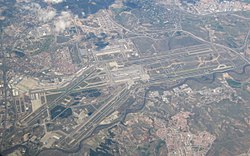Madrid–Barajas
|
Adolfo Suárez Madrid–Barajas Airport Aeropuerto Adolfo Suárez Madrid-Barajas |
|||||||||||||||||||||||
|---|---|---|---|---|---|---|---|---|---|---|---|---|---|---|---|---|---|---|---|---|---|---|---|
 |
|||||||||||||||||||||||
| Summary | |||||||||||||||||||||||
| Airport type | Public | ||||||||||||||||||||||
| Operator | ENAIRE | ||||||||||||||||||||||
| Serves | Madrid, Spain | ||||||||||||||||||||||
| Location | District of Barajas, Madrid | ||||||||||||||||||||||
| Hub for | |||||||||||||||||||||||
| Focus city for | |||||||||||||||||||||||
| Elevation AMSL | 610 m / 2,000 ft | ||||||||||||||||||||||
| Coordinates | 40°28′20″N 003°33′39″W / 40.47222°N 3.56083°WCoordinates: 40°28′20″N 003°33′39″W / 40.47222°N 3.56083°W | ||||||||||||||||||||||
| Website | http://www.aena.es/en/madrid-barajas-airport/index.html | ||||||||||||||||||||||
| Map | |||||||||||||||||||||||
| Location within Madrid | |||||||||||||||||||||||
| Runways | |||||||||||||||||||||||
|
|||||||||||||||||||||||
| Statistics (2016) | |||||||||||||||||||||||
|
|||||||||||||||||||||||
|
Sources: Passenger Traffic, AENA
Spanish AIP, AENA |
|||||||||||||||||||||||
| Passengers | 50,420,583 ( |
|---|---|
| Aircraft Movements | 378,150 ( |
| Cargo | 415,773 ( |
| Economic impact | $10.9 billion |
| Social impact | 130,900 |
Adolfo Suárez Madrid–Barajas Airport (Spanish: Aeropuerto Adolfo Suárez Madrid-Barajas [(a)eɾoˈpwerto aˈðolfo ˈswaɾeθ maˈðɾi(ð) βaˈɾaxas]) (IATA: MAD, ICAO: LEMD), commonly known as Madrid–Barajas Airport, is the main international airport serving Madrid in Spain. At 3,050 ha (7,500 acres) in area, it is the largest airport in Europe by physical size along with Paris–Charles de Gaulle Airport. In 2016, 50.4 million passengers used Madrid–Barajas making it the country's largest and busiest airport, and Europe's sixth busiest.
The airport opened in 1928, and has grown to be one of the most important aviation centres of Europe. Located within the city limits of Madrid, it is just 9 km (6 mi) from the city's financial district and 13 km (8 mi) northeast of the Puerta del Sol or Plaza Mayor de Madrid, the Madrid's historic centre. The airport name derives from the adjacent district of Barajas, which has its own metro station on the same rail line serving the airport. Barajas serves as the gateway to the Iberian peninsula from the rest of Europe and the world, and is a particularly key link between Europe and Latin America. The airport is the primary hub and maintenance base for Iberia. Consequently, Iberia is responsible for more than 40 percent of Barajas' traffic. The airport has five passenger terminals named T1, T2, T3, T4 and T4S.
The airport was constructed in 1927, opening to national and international air traffic on 22 April 1931, although regular commercial operations began two years later. A small terminal was constructed with a capacity for 30,000 passengers a year, in addition to several hangars and the building of the Avión Club. The first regular flight was established by Lineas Aéreas Postales Españolas (LAPE) with its route to Barcelona. In the 1930s, flights started to serve some some European and African destinations, the first international flights from the airport.
...
Wikipedia

